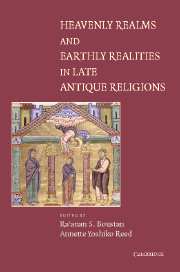Book contents
- Frontmatter
- Contents
- Preface
- List of Contributors
- Introduction: “In Heaven as It Is on Earth”
- PART ONE BETWEEN EARTH AND HEAVEN
- PART TWO INSTITUTIONALIZING HEAVEN
- 6 Earthly Sacrifice and Heavenly Incense: The Law of the Priesthood in Aramaic Levi and Jubilees
- 7 Who's on the Throne? Revelation in the Long Year
- 8 The Earthly Monastery and the Transformation of the Heavenly City in Late Antique Egypt
- 9 Contextualizing Heaven in Third-Century North Africa
- 10 Bringing the Heavenly Academy Down to Earth: Approaches to the Imagery of Divine Pedagogy in the East Syrian Tradition
- PART THREE TRADITION AND INNOVATION
- Select Bibliography
- Index
8 - The Earthly Monastery and the Transformation of the Heavenly City in Late Antique Egypt
Published online by Cambridge University Press: 14 July 2009
- Frontmatter
- Contents
- Preface
- List of Contributors
- Introduction: “In Heaven as It Is on Earth”
- PART ONE BETWEEN EARTH AND HEAVEN
- PART TWO INSTITUTIONALIZING HEAVEN
- 6 Earthly Sacrifice and Heavenly Incense: The Law of the Priesthood in Aramaic Levi and Jubilees
- 7 Who's on the Throne? Revelation in the Long Year
- 8 The Earthly Monastery and the Transformation of the Heavenly City in Late Antique Egypt
- 9 Contextualizing Heaven in Third-Century North Africa
- 10 Bringing the Heavenly Academy Down to Earth: Approaches to the Imagery of Divine Pedagogy in the East Syrian Tradition
- PART THREE TRADITION AND INNOVATION
- Select Bibliography
- Index
Summary
As it is done in heaven, so also on earth.
(Apoc. Paul 29, Paris MS)As it is on earth, so it is also in heaven.
(Apoc. Paul 29, Arnhem MS)Few Christian apocryphal texts have been as widely preserved and as influential in Late Antiquity, the Middle Ages, and Byzantium as the Apocalypse of Paul. A product of late fourth-century Egypt, this apocalypse is extant in more than a dozen languages, including Greek, Latin, Coptic, Syriac, and Arabic. The text was not only copied in monasteries but also was read aloud in churches throughout the Mediterranean by those who believed it to be the authentic revelation of the apostle Paul. Its impact can be felt in Christian literature across the spectrum, from late Coptic apocrypha to Dante's Inferno. The Apocalypse of Paul's importance as a reflection of the religious atmosphere of Late Antiquity is borne out by this volume, in which no fewer than three other articles refer to it.
This critically important Christian composition contains within it the most spectacular description of the heavenly Jerusalem since the Book of Revelation. At the end of the fourth century, when the Apocalypse of Paul envisions its “City of Christ,” the earthly Jerusalem has been an iconic center of Christendom for several decades. Yet, Constantine's Christian city does not inform this apocalypse's image of the heavenly Jerusalem despite its relative proximity to Egypt.
- Type
- Chapter
- Information
- Heavenly Realms and Earthly Realities in Late Antique Religions , pp. 142 - 158Publisher: Cambridge University PressPrint publication year: 2004
- 1
- Cited by



